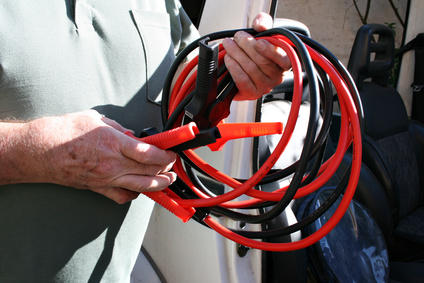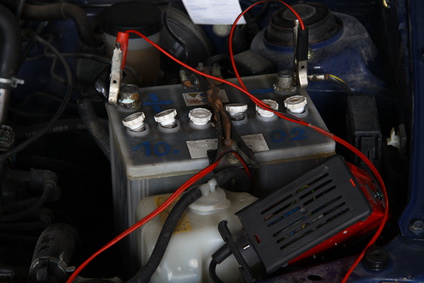So you forgot to turn off the dome light and it's been on all night, so the next morning the car doesn't make a sound when you try to start it. The starter won't crank, and all you hear is a weak clicking sound. The battery is most likely dead. This happens most often in winter and when driving mainly on short trips. It's not healthy for the battery when you're driving only six kilometers to work and back in temperatures below zero, with every possible power-draining device like heated seats, air conditioning, radio, and others are turned on.
Another problem in low temperatures: the colder it gets, the lower the viscosity of the motor oil. This means that the battery, in conjunction with the starter, has to work much harder to start the vehicle. You should only resort to old tricks like push- or pull-starting, or rolling the car to a start, when there are no other options out of your predicament, since these techniques actually do more harm than good. If the car doesn't start within the first few meters, unburned gasoline can seep into the catalytic convertor and damage it. Then, the tricks will only work on cars with manual transmissions. With automatic transmissions you'll have to call roadside assistance or get another driver to jump-start your car. When jump-starting, the proper sequence of connecting the cables is important. But to avoid having to do this in the first place, regular battery care is in order. In addition, you should only use high-drain devices like fog lights when they're absolutely necessary.
 |
Battery-charging technology has advanced quite a bit in the last ten years. Charging stations in the past were equipped with an internal transformer. These were mainly fitted into large housings and fairly heavy due to their wire coils. In modern chargers, microelectronics control the most important parameters. The new chargers can be much more compact than the older devices. However, there is a staggering variety of new chargers.
Most devices adjust themselves automatically, but there are some things which you always have to watch: One is that the current coming from the charger should be enough to properly charge the battery. It doesn't help to connect a high-capacity battery to a weak charger, since it will take several days to charge. Good chargers can deliver up to 3.5 amps per hour. So if your battery has a capacity of 70 Ampere-hours (Ah), charging should be complete after 20 hours. The other thing to be aware of is that the charger needs to be able to detect the battery's charge level and shut off when it is fully charged. Sufficient voltage will be 12 volts for cars and 6 volts for motorcycles and scooters. If your battery is not a conventional lead-based battery but instead a GEL battery or one with absorbent glass-fiber matting, then the charger needs to be compatible with these types.
| If your battery has been stored and unconnected for more than 12 months, it can become discharged. Then it may be necessary to charge it, since it will no longer have sufficient voltage to start the car. Driving on short trips or a faulty alternator are likewise bad for the battery. With these simple instructions you can charge the battery yourself. But before you connect the charger, you should carefully read its instruction manual as well as the safety instructions on the battery and also determine the correct voltage of your battery. |  |
Suddenly, in the first cold winter, the car no longer starts, even though the battery is new. Then you might ask: is the battery still covered under warranty? With car batteries, you need to distinguish between the manufacturer's warranty and the legally required warranty. The legally required warranty for customers lasts 24 months from the purchase date. This means that a dealer is responsible for all defects present in the battery at the time of purchase, even if a defect does not become evident until later on. On the other hand, the battery warranty is an additional, voluntary service of the manufacturer, not legally regulated. Its scope is specified in the warranty terms and conditions.
In years past, people simply dumped them on the side of the road, but nowadays nobody may simply dispose of a dead battery in this way. That is not only harmful to the environment, but also completely unnecessary, as there is a simple, cost-effective system for disposing of old batteries in an environmentally friendly manner. For this, the old battery is professionally disassembled and the individual components disposed of, including recyclable materials (lead and iron) as well as toxic substances (sulfuric acid and heavy metals).
Never with ordinary trash
It is prohibited by law to dispose of used starter batteries in household or residual trash. Standards and regulations which help you properly dispose of a car battery are encompassed in laws governing the sale, return, and environmentally friendly disposal of batteries, informally called battery law. According to the law, all dealers and workshops which sell car batteries are obligated to accept old batteries for disposal. Similar to a bottle-deposit system, when purchasing a new battery you'll pay a deposit of 7.50 Euros. You'll get this amount back when returning the used battery. If you want to buy a new battery from the same dealer to whom you're returning the old battery, this amount will simply be deducted from the purchase price. You cannot be forced to return the battery at the same location where you purchased it. You can return the battery for disposal anywhere batteries are sold, just hand in the redemption coupon. Recycling centers will also gladly take your old batteries, but they will not return your 7.50 Euro deposit.
Quantity: %entry-quantity%
Price per unit: %entry-formattedTotalPrice%